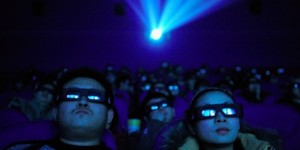First of New Generation of Ultra HD TVs Hits the Market
The new LG 84-inch Ultra HD TV model offers LG's Cinema 3D passive glasses technology and what the manufacturer describes as 3D sound, with 2.2 channel speakers. 3D glasses usually cut down on the resolution one actually sees, but, since there's so much definition to begin with, LG said the 3D is seen at 1080p.
8 Million Pixels
There are 8 million pixels per frame, or four times the resolution of current full HD TVs. Kwon said the new set is packed with "every advanced technology we currently have to offer," which includes a Resolution Upscaler Plus that allow images from hard drives and other external sources to be rendered in higher detail. ...
4k Programs?
In addition to space and price, there's also the little problem of content, since there is none in the 4K format. ...
See the full story here: http://www.sci-tech-today.com/news/First-Ultra-HD-TV-Hits-the-Market/story.xhtml?story_id=12100ESGV6S2
Fox Exec Danny Kaye Explains Why 3D Will Take Over The Home Viewing Experience
What have been the challenges of getting adoption of 3D TVs in homes?
The Consumer Electronics industry is growing so rapidly that confusion is inevitable when it comes to things like different features, different price points and competing technologies. The first challenge, in no particular order, is that features like this always come along with relatively higher priced models. 3D TVs were introduced during a recession. There was a slowdown of HD TVs that would carry along with it more rapid penetration of 3D TVs. That led to a choice between active and passive 3D technologies. At the last two CES shows we saw some pretty obvious distinctions between the approach of active versus passive 3D. Passive 3D has been associated with lower-priced TVs. The majority of 3D TVs coming out feature active technology by an 80/20 ration over passive. There the challenge is communicating to the consumer the different quality experience. Only with active are you getting full 1080 HD in both eyes versus half the resolution in passive. But does that matter to many consumers who wouldn’t be able to tell the difference? At the beginning of high def a similar thing happened and the industry struggled between 720 and 1080. Over time, people preferred to 1080p and that won over. Then you have the added feature of real-time 3D that many TVs offer, where you flip a switch and any content you’re watching becomes 3D even though it’s not nearly the quality of professionally produced 3D. With prices dropping on 3D TVs and the quality of active 3D glasses evolving, 3D is growing. If active 3D glasses are just as light and convenient as passive, then why wouldn’t you go that way. But both technologies are important for the industry today.
What role have 3D video games, mostly through PlayStation 3, had in getting some early adopters to upgrade?
Games are probably why a lot of PS3 gamers have upgraded to 3D. When PS3s were first purchased, the original motivation was gaming. But over time we saw that evolve to a movie device, as well. It’s the same thing with 3D. We’re still in a 7 to 10 year re-purchase TV cycle, where 30 to 40 million HD TVs are purchased in the U.S. each year. Consumers buying a second or third HD TV in the house may be for gaming or as a movie device. It’s the natural evolution of the penetration curve. You’re not going to buy the hardware unless there’s conent. Gaming and movies are the best 3D content.
See the full story here: http://www.forbes.com/sites/johngaudiosi/2012/10/25/fox-exec-danny-kaye-explains-why-3d-will-take-over-the-home-viewing-experience/
‘The Hobbit’ to Receive Dolby Atmos Sound Mix
 Peter Jackson says Atmos and high frame rates “allow the audience to participate in the events on screen, rather than watching them unfold.”
Peter Jackson says Atmos and high frame rates “allow the audience to participate in the events on screen, rather than watching them unfold.”
Peter Jackson has pushed the envelope in filmmaking with The Hobbit: An Unexpected Journey, which is he making in 3D and at a high frame rate of 48 frames per second — and now he is additionally focusing on audio with the decision to bring the sounds of Middle Earth to select theaters in Dolby’s immersive new sound format Atmos.
See the full story here: http://www.hollywoodreporter.com/news/hobbit-receive-dolby-atmos-sound-382197
Augmented reality enhances 3D printed building
In this 3D Printshow article, we focus on Inition, who were showing a world first proof of concept that could change the way architects design buildings, through a combination of AR and 3D printing.
See the full story here: http://www.3dfocus.co.uk/3d-news-2/3d-printing-3d-news-2/augmented-reality-enhances-3d-printed-building/10894
The Dark Side of 3D Printing
 One of the most recognizable 3D printer manufacturers, MakerBot, is stirring up another debate. MakerBot owns an open source design sharing website called Thingiverse.com. On Thingiverse, diagrams for printing a number of objects are shared everyday. Some of these are free for all to use, but many are copyrighted materials. The CEO of the company, Bre Pettis, doesn’t seem to think there’s much of a problem. “I don’t think we need a marketplace. It’s a sharing world. We are at the dawn of the age of sharing where even if you try to sell things the world is going to share it anyway.”
One of the most recognizable 3D printer manufacturers, MakerBot, is stirring up another debate. MakerBot owns an open source design sharing website called Thingiverse.com. On Thingiverse, diagrams for printing a number of objects are shared everyday. Some of these are free for all to use, but many are copyrighted materials. The CEO of the company, Bre Pettis, doesn’t seem to think there’s much of a problem. “I don’t think we need a marketplace. It’s a sharing world. We are at the dawn of the age of sharing where even if you try to sell things the world is going to share it anyway.”
See the full story here: http://303magazine.com/2012/10/the-dark-side-of-3d-printing/
Sydney Opera House to be laser scanned in Scottish Ten 3D project
 The Scottish Ten uses lasers to scan iconic locations, which include five Scottish World Heritage sites.
The Scottish Ten uses lasers to scan iconic locations, which include five Scottish World Heritage sites.
The Opera House will join Mount Rushmore in the US and the remote St Kilda ruins of Hirta on the list.
Culture Secretary Fiona Hyslop made the announcement at a digital conference in Edinburgh.
Read the full story here: http://www.bbc.co.uk/news/uk-scotland-edinburgh-east-fife-20027135
Is 3D Dying? Why Hollywood Is Putting Down the Glasses
 Part of the culprit is that studios are not increasing the number of films they release in 3D like they once were, and theater chains in the United States are not doing as much to expand their network of 3D compatible theaters after a building frenzy.
Part of the culprit is that studios are not increasing the number of films they release in 3D like they once were, and theater chains in the United States are not doing as much to expand their network of 3D compatible theaters after a building frenzy.
"Recent 3D releases have underperformed, screen build-out has slowed and ticket premiums are unlikely to increase," the study's authors write.
Thus far, 25 3D films have been announced for 2013, the study notes. That's about equal to the number of 3D films released this year (31) and in 2010 (23).
See the full story here: http://www.thewrap.com/movies/article/3d-boom-fizzling-and-ticket-prices-leveling-study-finds-60996